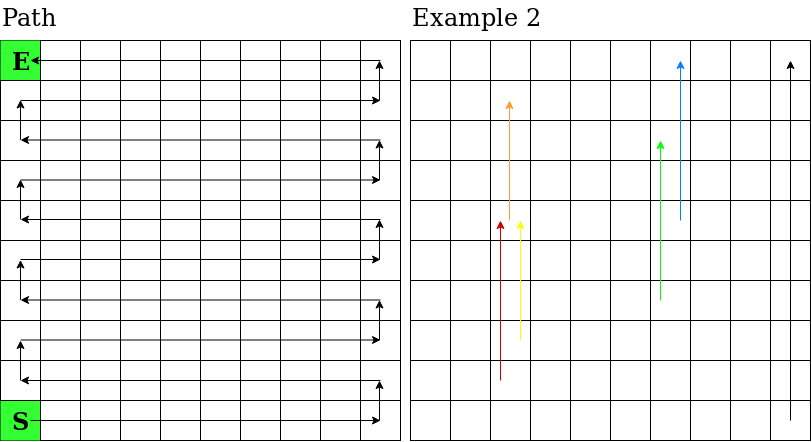Preparando MOJI
Hyakugoku has just retired from being the resident deity of the South Black Snail Temple in order to pursue her dream of becoming a cartoonist. She spent six months in that temple just playing "Cat's Cradle" so now she wants to try a different game — "Snakes and Ladders". Unfortunately, she already killed all the snakes, so there are only ladders left now.
The game is played on a $$$10 \times 10$$$ board as follows:
Please note that:
Hyakugoku wants to finish the game as soon as possible. Thus, on each turn she chooses whether to climb the ladder or not optimally. Help her to determine the minimum expected number of turns the game will take.
Input will consist of ten lines. The $$$i$$$-th line will contain 10 non-negative integers $$$h_{i1}, h_{i2}, \dots, h_{i10}$$$. If $$$h_{ij}$$$ is $$$0$$$, then the tile at the $$$i$$$-th row and $$$j$$$-th column has no ladder. Otherwise, the ladder at that tile will have a height of $$$h_{ij}$$$, i.e. climbing it will lead to the tile $$$h_{ij}$$$ rows directly above. It is guaranteed that $$$0 \leq h_{ij} < i$$$. Also, the first number of the first line and the first number of the last line always contain $$$0$$$, i.e. the Goal and the starting tile never have ladders.
Print only one line containing a single floating-point number — the minimum expected number of turns Hyakugoku can take to finish the game. Your answer will be considered correct if its absolute or relative error does not exceed $$$10^{-6}$$$.
0 0 0 0 0 0 0 0 0 0 0 0 0 0 0 0 0 0 0 0 0 0 0 0 0 0 0 0 0 0 0 0 0 0 0 0 0 0 0 0 0 0 0 0 0 0 0 0 0 0 0 0 0 0 0 0 0 0 0 0 0 0 0 0 0 0 0 0 0 0 0 0 0 0 0 0 0 0 0 0 0 0 0 0 0 0 0 0 0 0 0 0 0 0 0 0 0 0 0 0
33.0476190476
0 0 0 0 0 0 0 0 0 0 0 0 0 0 0 0 0 0 0 0 0 0 0 0 0 0 0 0 0 0 0 0 0 0 0 0 0 0 0 0 0 0 3 0 0 0 4 0 0 0 0 0 0 0 0 0 0 0 0 0 0 0 0 0 0 0 4 0 0 0 0 0 3 0 0 0 0 0 0 0 0 0 4 0 0 0 0 0 0 0 0 0 0 0 0 0 0 0 0 9
20.2591405923
0 0 0 0 0 0 0 0 0 0 0 0 0 0 0 0 0 0 0 0 0 0 0 0 0 0 0 0 0 0 0 0 0 0 0 0 0 0 0 0 0 0 0 0 0 0 0 0 0 0 0 0 0 0 0 0 0 0 0 0 0 6 6 6 6 6 6 0 0 0 1 0 0 0 0 0 0 0 0 0 0 0 0 0 0 0 0 0 0 0 0 0 0 0 0 0 0 0 0 0
15.9047592939
A visualization of the path and the board from example 2 is as follows: 
The tile with an 'S' is the starting tile and the tile with an 'E' is the Goal.
For the first example, there are no ladders.
For the second example, the board looks like the one in the right part of the image (the ladders have been colored for clarity).
It is possible for ladders to overlap, as is the case with the red and yellow ladders and green and blue ladders. It is also possible for ladders to go straight to the top, as is the case with the black and blue ladders. However, it is not possible for ladders to go any higher (outside of the board). It is also possible that two ladders lead to the same tile, as is the case with the red and yellow ladders. Also, notice that the red and yellow ladders lead to the tile with the orange ladder. So if the player chooses to climb either of the red and yellow ladders, they will not be able to climb the orange ladder. Finally, notice that the green ladder passes through the starting tile of the blue ladder. The player cannot transfer from the green ladder to the blue ladder while in the middle of climbing the green ladder.